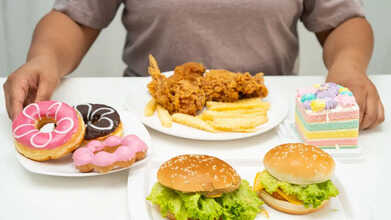- Health Conditions A-Z
- Health & Wellness
- Nutrition
- Fitness
- Health News
- Ayurveda
- Videos
- Medicine A-Z
- Parenting
Protein Bars Are Not As Healthy As You May Think They Are - Avoid These Components For Future Buys

(Credit-Canva)
When it comes to saving time, we have built many things, from quicker transportation to smart home appliances. These things reduce not just the process as well as the effort so that we can focus on more important things. Similarly, protein bars were not only an easy but also efficient way to get your daily nutrient intake. However, are they as healthy as they seem?
Less Protein, Lower Quality?
A new study published in Scientific Reports (Nature) raises questions about the actual nutritional value of many protein bars. The study found that a significant number of the 1,600+ bars tested contained less protein than advertised. Even more concerning, the quality of the protein in most bars was often poor, impacting how well your body can absorb it.
What the Study Found?
Researchers looked at information from a large online database of food products. They started with about 4,600 protein bars. Many of these bars were from the U.S., so it's likely that a lot of the 1,641 bars they ultimately tested are available where you shop. The researchers divided the bars into groups based on their protein type:
- Only plant protein (like from peas or rice)
- Only animal protein (like from milk)
- A mix of milk, egg, and soy protein
- A mix of milk, collagen, and soy protein
Many bars weren't actually "high protein"
While most bars got at least 20% of their calories from protein, about one-fifth of them didn't. This standard is actually stricter than what our food authorities consider "good" or "excellent" sources of nutrients.
Protein in some bars was hard to digest
How well the protein in the bars could be digested varied a lot, from less than half to over three-quarters. Surprisingly, some bars with proteins generally considered "high-quality" (like animal protein or soy) were harder to digest. High-quality proteins are important because they contain all the necessary building blocks your body can't make itself, and they're usually well-absorbed for muscle repair and growth.
Protein Bars: Go or No Go
Because so many people are trying to eat more protein, it's easy to think all protein bars are healthy. But this new study shows an important truth: the overall nutrition of a food can't always be judged by just one thing, like its protein content. Even if a bar has good protein, your body might not fully use it.
It's also worth remembering that protein bars are often highly processed. Eating a lot of these ultra-processed foods might be linked to health problems like a higher risk of obesity, heart disease, and type 2 diabetes.
On the other hand, for some people, protein bars can be very useful. If you have higher protein needs, or if your appetite isn't great (maybe due to medication or illness), a protein bar offers a convenient way to get a protein boost in a small serving. But even then, they shouldn't be your only protein source; they should be a supplement.
For better quality protein in a less processed form, consider options like Greek yogurt, cottage cheese, hard-boiled eggs, jerky, nuts, and seeds. These also offer other good nutrients like calcium, healthy fats, and fiber.
How to Pick a Healthier Protein Bar
If you still want to choose a protein bar, here are some tips:
Look for higher protein
Even if other ingredients affect how well protein is digested, it's still smart to choose bars with more protein. Ideally, this protein should come from animal sources like whey or milk, or from plant sources like soy or pea.
Check for low added sugar
While there isn't a strict rule for "low" added sugars, it's recommended to keep your added sugar intake to less than 10% of your total daily calories.
Drinking Water Is Even More Important During Winters, According To Doctor

Credits: iStock
As a harsh cold wave swept across North India, doctors noticed a quiet but worrying trend inside emergency rooms—more people were showing up dehydrated, even though temperatures were at their lowest. Health and Me spoke to Dr. Swadesh Kumar, Cluster Head – Emergency and Trauma Care & Casualty, Gurugram, to understand why winter dehydration is often missed and how it can turn dangerous if ignored.
When Cold Weather Creates a False Sense of Safety
Winter is usually associated with hot drinks, cozy layers and fewer reminders to sip water. According to Dr. Kumar, this mindset is exactly where the problem begins. “People assume that because they’re not sweating or feeling thirsty, their body doesn’t need as much water. That’s a misconception,” he explains.
During cold spells, thirst signals are naturally suppressed. At the same time, the body continues to lose fluids through dry air, indoor heating and even breathing. “The loss is gradual and silent, which makes winter dehydration harder to spot,” Dr. Kumar adds.
A Rise in Winter Emergency Cases
Hospitals across northern states reported a seasonal increase in dehydration-related complications during the cold wave. These weren’t always dramatic cases. Patients often came in with dizziness, fatigue, confusion or sudden changes in blood pressure.
“In many emergency visits, dehydration wasn’t suspected initially because there was no heat exposure or fever,” says Dr. Kumar. This delay allowed symptoms to worsen before treatment was started.
How Dehydration Worsens Existing Conditions
Low fluid intake doesn’t just cause weakness, it can aggravate underlying health problems. When the body is dehydrated, blood becomes thicker, increasing the risk of clot formation. This is particularly dangerous for older adults and people with heart disease.
Kidneys are also affected. Reduced hydration puts extra strain on them, sometimes leading to acute kidney injury. “We see patients with palpitations, fainting spells and extreme weakness, only to later realize dehydration is the root cause,” Dr. Kumar notes.
Respiratory Infections Add to the Risk
Winter illnesses further complicate the situation. Fever, rapid breathing and certain medications increase fluid loss. Yet many people intentionally avoid drinking water to reduce bathroom visits in the cold.
“This combination is especially risky for children and the elderly,” Dr. Kumar says. Children depend on caregivers for hydration reminders, while older adults naturally feel less thirsty. Both groups can slip into dehydration quickly during winter infections.
Indoor Heating: The Hidden Culprit
Room heaters and blowers dry out indoor air, leading to unnoticed moisture loss through the skin and breath. People spending long hours indoors often underestimate this effect.
Early signs like dry lips, headaches and muscle cramps are commonly ignored. By the time medical help is sought, dehydration may already have disrupted blood pressure or electrolyte balance.
Subtle Warning Signs Often Missed
Unlike summer dehydration, winter dehydration doesn’t come with intense thirst. Dark urine, reduced urination, constant tiredness and mild confusion are frequent clues but are often blamed on cold weather or poor sleep.
“In severe cases, dehydration can contribute to sudden falls, worsening chronic illnesses and emergency admissions,” Dr. Kumar warns.
Simple Habits Can Prevent Serious Risk
Doctors advise treating hydration as a routine, not a response to thirst. Warm water, soups, stews and herbal drinks are practical winter options. Fruits with high water content also help, even when appetite is low.
“Monitor urine color, limit excess caffeine and be extra careful if you have a chronic condition,” Dr. Kumar advises.
The cold wave is a reminder that dehydration isn’t just a summer problem. Even in winter, the body needs adequate water to function, and ignoring that need can quietly turn into a medical emergency.
8 Natural Ingredients That Work Like Weight Loss Jabs Without Side Effects

Credits: Canva
With 28 percent of adults in the UK now classified as obese and another 36 percent considered overweight, it is unsurprising that weight-loss injections have surged in popularity. Estimates suggest around 1.5 million people are currently using these jabs each month.
While the injections can lead to significant weight loss, experts warn that they come with notable risks and often fail to address the root causes of weight gain. Mike Wakeman, a researcher, pharmacist, and founder of Evera Nutrition, explained how these medications work and why they may fall short in the long term.
“These medicines mainly act by increasing two gut hormones, GLP-1 and GIP. These hormones reduce appetite, increase feelings of fullness, and slow stomach emptying,” he said. “The problem is that many people rely on medication alone.”
Why Weight-Loss Jabs May Not Solve the Problem
Wakeman pointed out that several underlying contributors to weight gain are frequently overlooked. “Stress, poor sleep, alcohol misuse, binge eating, and even certain medications or hormonal and medical conditions, such as an underactive thyroid, are often ignored when discussing weight issues,” he said. “If these factors are not addressed, they will still be present at the end of treatment and are likely to trigger weight regain.”
Recent research supports this concern. Studies have found that participants regained almost all of the weight they lost within a year of stopping weight-loss injections.
Weight Loss Jabs Side Effects and Long-Term Risks
Side effects linked to weight-loss jabs are common and include nausea, vomiting, constipation, and acid reflux. More serious health issues have also been reported in some individuals. These include pancreatitis, gallbladder problems, and depression. Rapid weight loss can result in muscle loss, while hair thinning and vision problems have also been associated with the use of these injections.
Natural Ingredients That Work Like Weight Loss Jabs Without Side Effects
According to specialists, growing scientific evidence suggests that certain natural ingredients may help support healthy weight loss when combined with proper diet and lifestyle changes, without the same side-effect profile seen with injections.
“The good news is that some natural ingredients can mimic the effects of GLP-1,” Mike said. “These include glucomannan, which is a type of fibre, along with resveratrol, hibiscus, green tea, berberine, curcumin, cinnamon, and mulberry.”
Ingredients That Act Like ‘Natural Weight-Loss Jabs’
Explaining the science behind these ingredients, Wakeman broke down how each one may support weight management.
“Glucomannan is a natural fibre derived from the konjac root. It expands in the gut, helping you feel full, and may also increase GLP-1 levels,” he said, as per Mirror. “Resveratrol, found in foods such as grapes, has been shown to significantly reduce body weight, waist circumference, and BMI.”
“Hibiscus has been shown to reduce obesity, abdominal fat, and blood lipid levels,” he added. “Catechins like EGCG, found in green tea, have been linked to meaningful reductions in body weight, BMI, and waist circumference, particularly at higher doses and over longer periods, when combined with a healthy diet and exercise. They also help boost metabolism and fat burning.”
“Berberine is a plant compound that, according to a meta-analysis of 12 studies, reduces body weight, BMI, and waist circumference,” he said. “Curcumin, the active compound in turmeric, has also shown strong evidence. An umbrella meta-analysis covering 14 systematic reviews and 39 randomised controlled trials found that curcumin supplementation reduces body weight, BMI, and waist size, while also improving blood sugar and blood fat levels.”
“Cinnamon may help reduce weight by improving blood sugar control,” Wakeman continued. “A meta-analysis of 12 trials involving 734 people found that cinnamon intake lowered body weight, BMI, and waist circumference. Mulberry has also shown anti-obesity effects, including activating brown fat.”
How Some Ingredients May Boost GLP-1 Further
Wakeman also noted that certain ingredients may work by slowing the breakdown of GLP-1 and GIP. “Some compounds may help inhibit Dipeptidyl Peptidase-4, or DPP-4,” he said. “DPP-4 is an enzyme that breaks down GLP-1 and GIP. When this enzyme is blocked, these hormones remain active for longer.”
Ingredients that may play a role in DPP-4 inhibition include curcumin, resveratrol, cinnamon, maritime pine bark extract, blackcurrant, mulberry, quercetin, and rosemary.
Could Food Preservatives Be Fueling Cancer and Type 2 Diabetes? What Studies Suggest

Credits: Canva
Common preservatives added to foods to prevent spoilage and increase shelf life may be linked to a higher risk of several cancers and Type 2 diabetes, according to two new studies from France.
“These are very important findings for preservatives that are not only widely used in the French and European markets, but also in the United States,” said senior author Mathilde Touvier, principal investigator of the NutriNet-Santé study used for the research, as per CTV News. The NutriNet-Santé study, launched in 2009, tracks more than 170,000 participants by comparing their web-based diet and lifestyle reports with medical data recorded in France’s national health-care system.
“These are the first two studies in the world to investigate the link between exposure to these food additives and cancer and Type 2 diabetes,” said Touvier, who is also director of research at France’s National Institute of Health and Medical Research in Paris. “That means we must be cautious in interpreting the findings. The results clearly need confirmation.”
Katz, who was not involved in the research, is a preventive and lifestyle medicine specialist and founder of the non-profit True Health Initiative, a global group focused on evidence-based lifestyle medicine.
Cancer And Preservatives: Is There A Link?
The cancer-focused study, published in The BMJ, examined the effects of 58 preservatives among nearly 105,000 people who were cancer-free in 2009 and followed for up to 14 years. Only participants who regularly completed detailed 24-hour, brand-specific food questionnaires were included. Those consuming the highest levels of preservatives were compared with those consuming the least.
Researchers closely analysed 17 preservatives eaten by at least 10 percent of participants. Eleven showed no link to cancer. However, six preservatives that were associated with cancer are classified as GRAS, or “generally recognized as safe,” by the US Food and Drug Administration. These include sodium nitrite, potassium nitrate, sorbates, potassium metabisulfite, acetates, and acetic acid.
Sodium Nitrite Linked To Cancer
Sodium nitrite, commonly used in processed meats such as bacon, ham, and deli meats, was linked to a 32 percent higher risk of prostate cancer. Potassium nitrate was associated with a 22 percent increased risk of breast cancer and a 13 percent rise in overall cancer risk. The World Health Organization has long classified processed meat as carcinogenic, with a well-established link to colon cancer.
Sorbates, particularly potassium sorbate, were associated with a 26 percent higher risk of breast cancer and a 14 percent increase in overall cancer risk. These preservatives are commonly used in wine, baked goods, cheese, and sauces to prevent the growth of mold and yeast.
Potassium metabisulfite, widely used in winemaking and brewing, was linked to a 20 percent increase in breast cancer risk and an 11 percent rise in overall cancer risk.
Acetates, which are derived from natural fermentation and added to foods such as meat, sauces, breads, and cheese, were associated with a 25 percent higher risk of breast cancer and a 15 percent increase in cancer overall. Acetic acid, the main component of vinegar, was linked to a 12 percent increase in overall cancer risk.
Other preservatives were also examined, including antioxidants like vitamin C and vitamin E, plant-based extracts such as rosemary, and synthetic additives like butylated hydroxyanisole. While these substances are often linked to lower cancer risk when consumed as part of whole foods, their effects may differ when added as isolated compounds, Touvier explained.
Only two antioxidant preservatives were linked to cancer. Sodium erythorbate and related erythorbates, derived from fermented sugars, were associated with a 21 percent higher risk of breast cancer and a 12 percent increase in overall cancer risk.
Erythorbates are commonly used to prevent discoloration and spoilage in poultry, soft drinks, and baked goods. Sodium erythorbate is also frequently added to processed meats to speed up curing. While observational studies can be affected by uncontrolled variables, an editorial published alongside the research noted its strengths, including detailed dietary assessments and adjustments for preservatives from natural sources and other food additives.
Both studies adjusted for factors such as physical activity, smoking, alcohol intake, medication use, and lifestyle habits. “The finding that specific classes of preservatives are associated with increased risk of certain cancers remained consistent even after these adjustments, showing the issue deserves serious attention and further study,” Katz added.
Type 2 Diabetes And Preservatives
The second study, published Wednesday in Nature Communications, explored the association between preservative intake and the risk of Type 2 diabetes in nearly 109,000 NutriNet-Santé participants who did not have diabetes at the beginning of the study.
Of the 17 preservatives analysed, 12 were linked to nearly a 50 percent higher risk of developing Type 2 diabetes among those with the highest consumption.
Five preservatives already linked to cancer, potassium sorbate, potassium metabisulfite, sodium nitrite, acetic acid, and sodium acetate, were also associated with an increased risk of Type 2 diabetes, with risk rising by 49 percent.
A sixth preservative, calcium propionate, a white powder used to prevent mold and bacterial growth, was also linked to a higher diabetes risk.
The study also found that several antioxidant additives were associated with increased diabetes risk. Additives linked to a 42 percent increase included alpha-tocopherol, the most readily absorbed form of vitamin E; sodium ascorbate, a buffered form of vitamin C; rosemary extracts; sodium erythorbate; phosphoric acid, commonly found in sodas, processed meats, and cheese; and citric acid, a preservative and flavour enhancer with little nutritional value.
Because these are the first studies to examine the role of preservatives in the development of cancer and Type 2 diabetes, further research is needed to confirm and expand on the findings, said Anaïs Hasenböhler, the lead author of both studies and a doctoral researcher at Université Sorbonne Paris Nord.
© 2024 Bennett, Coleman & Company Limited

